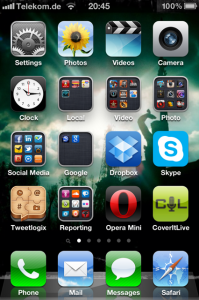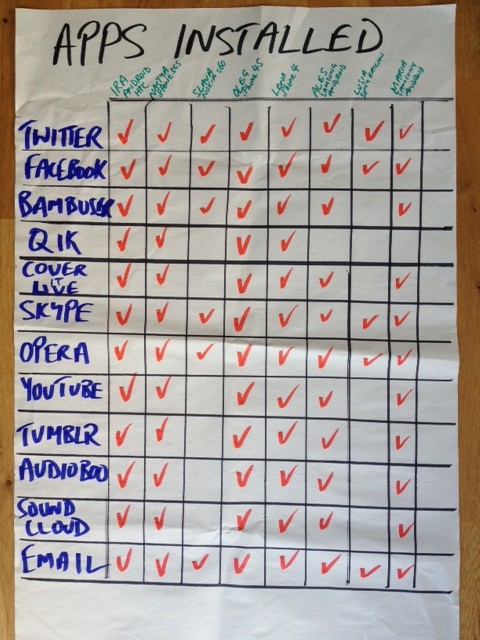Training mobile journalism – more than just apps (Part 1)
Using a mobile phone effectively for reporting is becoming more established in newsrooms.
And along with the ever increasing range of applications, journalism training and media development agencies are turning their attention to offering mobile journalism courses and mobile content producing courses for citizen media.
This is positive. But there are plenty of traps along the way in offering mojo training.
Here on the DW Akademie Africa blog, we’re always keen to explore multimedia apps and innovative ways journalists can use a mobile phone for their work.
In the first of two blog posts, we’ll take a look at some points journalism trainers should consider when setting out to develop mobile journalism courses.
The phones and their operating systems
We live in a world where there are some 6 billion mobile phone subscriptions and the sales of smartphones are increasing.
Every phone is different. This is great for competition between the big manufacturers, mobile computing development, and ultimately mobile journalism. But it can drive a well intentioned trainer to hide behind their flip chart and chew nervously on a marker pen.
Conducting a training course using one model of mobile phone on one mobile operating system is of course training bliss. A trainer literally only has to speak one language.
But depending on where you are conducting your training that may be highly unlikely. Be prepared for participants attending courses with different types of phones and operating systems.
The main smartphone operating systems you’ll usually encounter include:
Android
iOS
RIM Blackberry
Symbian (Nokia)
Windows
Of course under the banner of smartphones you might also see a few cheap copy phones using some weird and wonderful operating system turn up. In this case it’s useful to have a couple of extra smartphones for participants to use. You can waste a lot of valuable training time trying to make workarounds on phones that really are not up to the task.
It must be said that Apple’s iPhone is at the moment the device that offers the most comprehensive range of multimedia applications that are useful for journalists.
The iPhone is a powerful tool but a hugely expensive device, even for older models. However, the entry level to using an Android based phone is far cheaper and many app developers produce apps that function on both iOS and Android.
An Android phone is a good option to recommend to journalists or newsrooms looking to upgrade to a new phone. Trainers should also take a look around local markets or phone shops and get a feel for what phones are actually available in-country.
Getting connected
With a dozen or so mobile devices and laptops all trying to connect to the internet at the same time, you’ll need a reliable and fast internet connection in your training room. Sure everyone could probably log on to the net via a local mobile network but this might start to run up your training costs.
If your training room WiFi is failing, move location. Be mobile. Set up at a local internet cafe or find an alternative quickly.
Using a combination of a projector and a large TV display can also be very effective for training. You can screen presentation slides through the projector, and connect a mobile phone to the large TV display to demonstrate applications live.
There are VGA or HDMI cables and adapters available for most mobile phones.
Try free apps first
Yes many purchase applications offer more options for producing content or exporting, but you can do a lot with free applications.
Rather than overwhelming participants with dozens of whiz-bang apps, think less is more. Start working with a few apps that are well established.
Here’s a list of free multimedia apps that can form the basis of an introduction to mobile journalism training course (June 2012)
Audioboo (iOS, Android, Nokia, plus Boomail via email)
Soundcloud (iOS, Android)
Tumblr (iOS, Android, Blackberry, plus email for other phones)
Dropbox (iOS, Android, Blackbery)
Bambuser (many mobile phones)
Opera browser (all mobile phones)
Instagram (iOS, Android)
PS Express (iOS, Android)
Participants should also install a Twitter and Facebook application.
And as a bonus tip, If This Then That is a very handy web tool that could provide a workaround for publishing and sharing content from a mobile phone, especially via email and RSS.
Getting those apps installed
From a trainer or project manager perspective, the most effective courses are often the ones where the local partner is both highly organized and briefs participants very well before the course.
For a dream mobile journalism course, all participants would arrive at the course with:
– a functioning phone
– up to date phone firmware
– correct username and password for app stores
– correct username and password for social media accounts
– a mobile email app that is actually working
– functioning mobile charger and cables
– and importantly, all the applications necessary for the course already installed as per your pre-course preparation notes.
The reality is to expect none of the above.
Given the variety of mobile phones and operating systems you might be dealing with something is bound to go wrong. So program sufficient time for app installation trouble-shooting.
And if you’re working with a translator, make sure you run them through each app installation and account opening procedure. Translators often have a tricky time trying to put your words into action.
If you’re running a short course, one useful option is to open a generic Gmail email address and use generic training accounts for multimedia mobile applications. That way you can get participants logged into applications, up and running much much quicker.
It might be a high tech mobile training course but don’t forget lo-tech visual aids for course organization are essential.
This easy to produce flip chart table is a quick way of checking at a glance which participant has what application installed.You can even ask participants to check off applications themselves as they are installed.
It’s also a simple way for newsrooms to be organized and keep track of the apps installed on colleagues’ mobile phones.
In Part 2 of training mobile journalism, Guy Degen will take us through some principles for developing mobile journalism workflow, and tips for conducting mojo training assignments.





Feedback